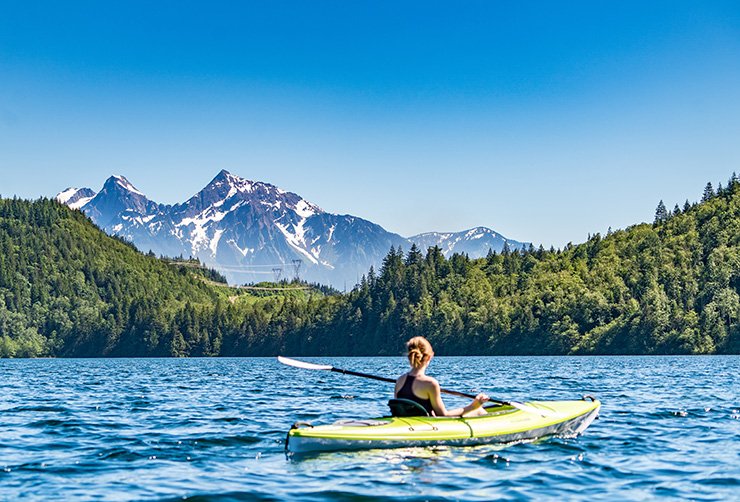Getting into kayaking is exciting. But then you spend some time with fellow kayakers to learn a thing or two, and you can hardly understand what they’re saying. Kayaking has been around for a long while, and like every other discipline, there are terms only ‘insiders’ know.
But not to worry. I have compiled a long list of kayaking terms and their meanings. The next time you’re among kayakers, you can confidently contribute to the conversation like everybody else.
So read on!
100+ Kayaking Terms and What They Mean
A
Access Point
The spot where you put in to begin or take out to end your kayaking trip, usually along the shore of a body of water.
Aground
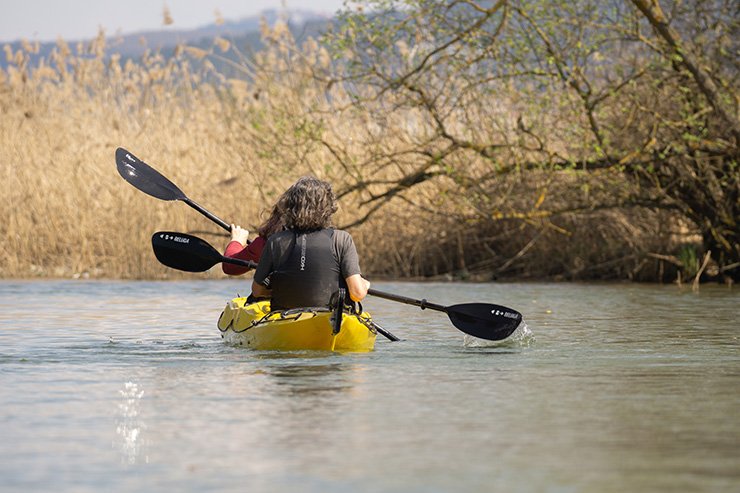
If your kayak runs aground, it has touched the ground or bottom under the water and is most likely stuck. It happens when the water is too shallow–you must get off and push the kayak to deeper water.
Anchor
You use this accessory to keep your kayak in place so it doesn’t drift away. Kayak anchors are especially great for anglers.
Angle
The angle of the paddle when the kayaker is doing a forward stroke. It could be a high or low angle (see high angle and low angle further below).
Assisted Rescue
A kayaker helping another kayaker get back into their kayak after capsizing. There are different types of assisted rescue techniques exist, such as T rescue and heel hook rescue.
B
Back Band
Some form of back support that is intended to keep the kayaker upright while seated in the kayak.
Backcountry
A remote location that is hard to access, also known as a backwater.
Bilge Pump
An accessory that you use to remove water from the cockpit after your boat capsizes. It’s not necessary for sit-on-top recreational kayaks since they have drain plugs, but it’s a must-have for sit-ins, especially touring and sea kayaks.
Blade
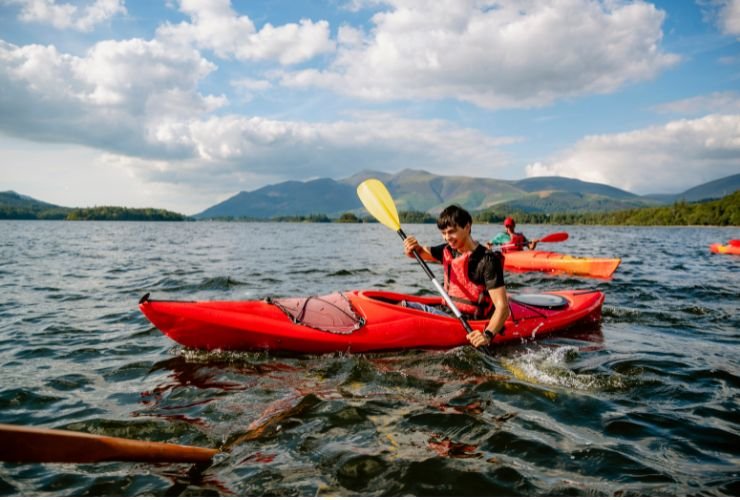
The wide, flat part at either end of a kayak paddle that you immerse in the water to propel your kayak.
Bow
The front end of a kayak.
Bracing
Bracing is an emergency technique that you can perform to prevent your kayak from capsizing. There is a high brace and a low brace–both are important to learn.
Bulkhead
This is a vertical wall inside the hull of a kayak that creates a water-tight compartment, usually at the front and back. Its main purpose is to create buoyancy and also for storage, usually in sea and touring kayaks.
Bungee Cords
Cords use to create a storage system on the deck of your kayak. Some kayaks already come with a bungee storage area.
C
Capsize
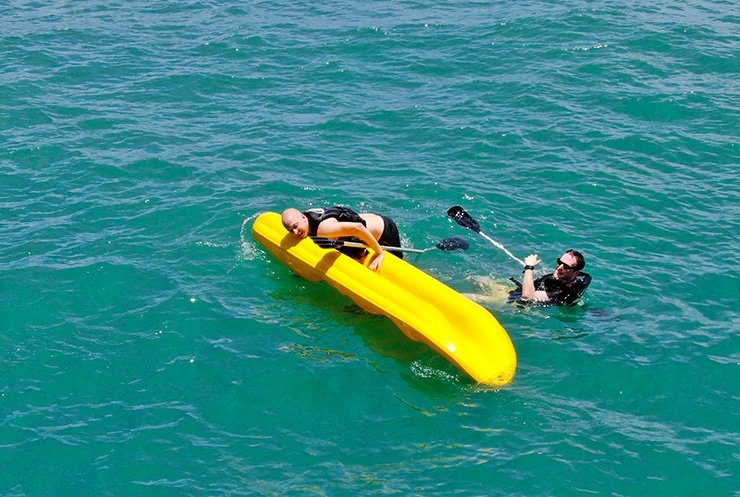
The act of a kayak overturning. When this happens, you’ll have to perform self-rescue or have a seasoned kayaker perform an assisted rescue.
Carabiner
A link with a closure that you can use to attach gear and accessories or for towing your kayak.
Chine
Where the side of the kayak and the bottom meet. Kayaks can have a soft chine, a gentle curve that looks more rounded, or a hard chine with more defined edges.
Cockpit
The area in the hull where the kayaker sits while paddling.
Current
Water flowing in a certain direction, usually from a higher point to a lower point in rivers.
D
Deck
The top part of a kayak.
Downriver Race
A competitive kayak sport that involves descending a significant distance of challenging whitewater. It’s also known as Wildwater.
Downstream
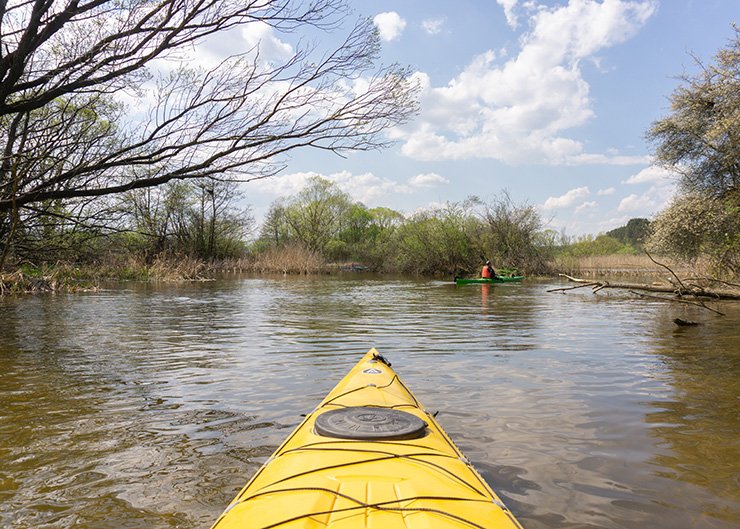
If you are kayaking downstream, you are kayaking in the direction of the current in a river.
Drag
The resistance created against the kayak as it moves through the water, similar to the concept of friction.
Drain Plugs
These provide an avenue to drain any water that may have entered the hull of your kayak.
Draw Stroke
This is achieved by immersing the paddle blade on the side of the kayak, a foot or two away, and pulling it towards you. Use this stroke when you want to move your kayak sideways, maybe closer to another kayak.
Dry Bag
A waterproof bag that paddlers use to store their valuables to keep them from getting wet.
Dry Suit
Completely waterproof piece of clothing designed to keep you dry when in or around the water. Dry suits are loose, and you can wear more thermal layers inside to keep you warm.
E
Eddy
When there’s an obstacle, like a rock, in a stream or river, it can interrupt the natural flow of the current causing it to flow in a circular motion–that’s an eddy. Right behind the obstacle, you may find the water flowing gently upstream, and this is usually a nice place to rest.
Edging
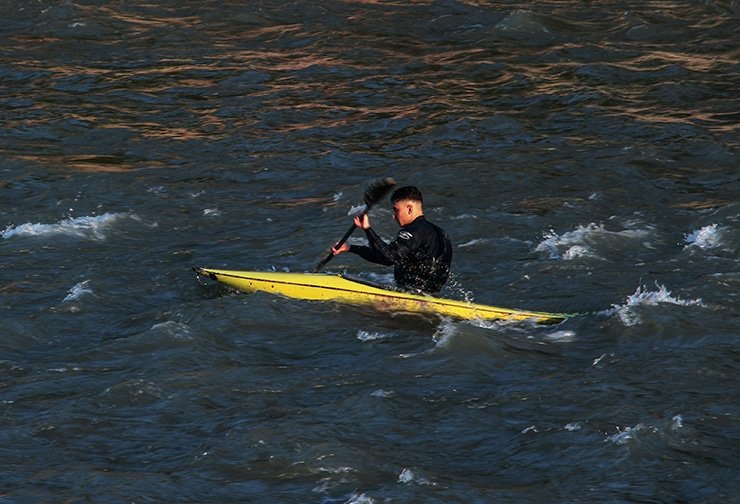
Tilting the kayak towards one side while still maintaining balance to make it more maneuverable. It’s an important skill for sea kayaking as sea kayaks are long, and this technique helps you make a sharper or quicker turn.
Eskimo Roll
The act of righting a capsized sit-in kayak using your body and paddle–all without getting out of the kayak.
Entrapment
This is when you get stuck in a capsized kayak, unable to get out, or when you get trapped by a strainer or other obstacles underwater. It can be a scary and dangerous situation.
F
Feather
When you feather your kayak paddle, you adjust it such that the blades are offset and at an angle to each other as opposed to being straight and aligned.
Fiberglass
A fiber-reinforced plastic material that’s used to make kayaks and kayak paddles.
Flare
A signaling device that produces a bright flame to signify distress and will help show your location to rescuers.
Flatwater
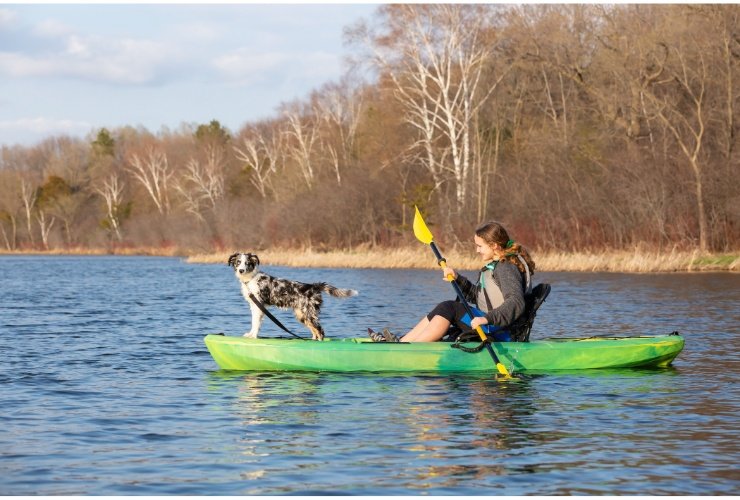
This is a calm body of water. Examples include slow-moving rivers, sheltered bays, or any other kayaking location without serious currents and waves.
Float Bags
Also called floatation bags, they help keep your kayak afloat in case you capsize by displacing water in the kayak and making it more buoyant.
Float Plan
A description of your kayak trip, including where you’re going, other paddlers you might be going with, when you expect to get back, what to do if you’re not back, and any other details that may help rescuers find you if you get in trouble.
Foot Pegs
Foot pegs or foot braces are where your feet rest when you’re in the kayak. They help you paddle efficiently and come in handy when edging (see edging above).
Forward Stroke
This is the most basic stroke used to propel the kayak forward. You do it by immersing your kayak blade fully in the water, right next to the kayak, drawing back, and slicing the blade out when it gets to your hips.
G
Grab Handles
Typically found at the kayak’s bow and stern, these are handles that help with carrying the kayak.
H
Hatch
You can find hatch openings at the bow and stern of your sit-in kayak, especially if it’s a sea kayak. Hatches allow you to access bulkheads (see bulkhead above) and use them for storage. The two terms are used interchangeably sometimes.
Heel Hook
This is a type of assisted rescue that relies more on leg and lower body strength and less on upper body strength.
High Brace
A way of bracing yourself while kayaking to prevent your boat from capsizing. You basically hold your paddle at shoulder height, parallel to the water, with the power face of the blade facing the water. Then slap the water to get the support you need.
Hole
Where water drops over an obstacle in a river into deeper water, causing the water on the surface to flow back towards the obstacle.
Hull
The bottom part of your kayak that’s in contact with the water surface.
Hypothermia

This is when your body temperature drops to a dangerously low level. It occurs when you’re submerged in cold water or exposed to cold weather without proper clothing.
I
Inflatable kayaks
Kayaks made from Hypalon, Nitrilon, or, PVC, that need to be inflated before use. The main advantages of inflatable kayaks are ease of storage and transport.
J
J-Cradle
A J-shaped kayak carrier that allows you to carry your kayak(s) on its side on the roof of your car. The kayak doesn’t take up much space with this carrier so you can fit multiple kayaks or other gear.
K
Kayak
A small, narrow watercraft propelled by paddling using a double-bladed paddle.
Keel
The ridge of the hull, from the bow to the stern. A more defined keel enhances the speed and tracking of your kayak.
Kevlar
A type of aramid fiber that is super strong and tough. It’s used to make rigid but lightweight kayaks. Kevlar kayaks can be quite expensive, but they have superior performance.
L
Launch
This term can be used to refer to an access point in the water or the act of sliding your kayak into the water to begin your kayaking adventure.
Lee
The side that is sheltered from the wind.
Life Jacket
Also known as a life vest, a life jacket is a kayaking safety accessory that’s designed to keep you afloat if you fall into the water.
Low Brace
In a low brace, you hold your paddle lower, below your elbows, and slap the water using the back of the blade.
N
Neoprene
A synthetic rubber that is used to make wetsuits and other clothes for cold weather kayaking.
O
Open Water
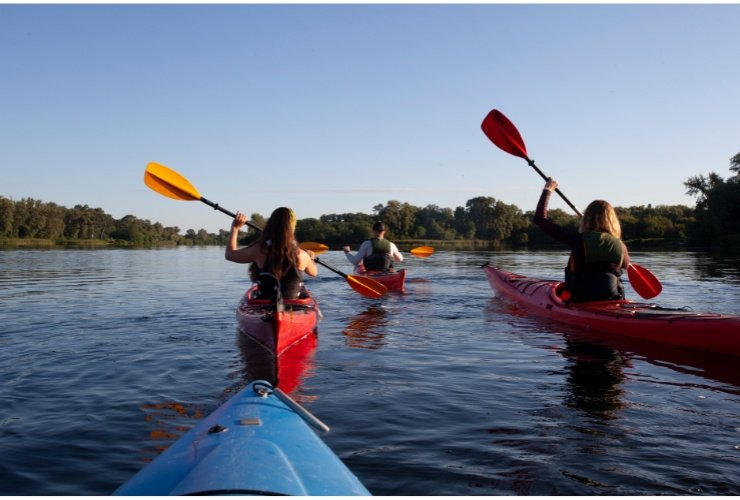
A large area of water without any kind of protection from the wind, usually an ocean or big lake. Open water kayaking is much less forgiving and best suited for kayakers with experience.
Outfitter
A shop that sells gear and supplies for certain outdoor activities, in this case, kayaking. Others offer tours and lessons too.
Offshore Winds
This is a wind blowing from the land towards the sea.
Onshore Winds
This is a wind blowing from the sea towards the land.
P
Paddle
A pole with a blade on one or both ends used to propel kayaks, canoes, paddle boards, and other paddle craft. A kayak paddle has two blades–one on either end.
It could also refer to the act of propelling watercraft using a paddle.
Paddle Leash
A long cord that you use to attach your paddle to your kayak to prevent it from getting lost if you capsize.
Personal Flotation Device

Usually abbreviated as PFD, a personal floatation device is a safety accessory that you wear to keep you from drowning if you fall into the water. It could be a life vest, PFD belt, or PFD harness.
Portage
Carrying your kayak over a piece of land, usually to go from one waterway to another or get around an obstacle. Read more about how to portage your kayak.
Power Face
The curved side of the paddle blade that faces you when you’re making a paddle stroke.
Primary Stability
Also called initial stability, this is the stability of your kayak when it is sitting flat on the water. Rec boats and fishing kayaks tend to have higher primary stability. A kayak like this is also ideal for beginners.
Put-In
Where you launch your kayak and begin your paddling trip.
R
Rapid
A section of the river with turbulent, fast-flowing water. Rapids are classified by numbers related to their severity.
Rapid Classes
A classification system that categorizes rapids into classes to show their level of difficulty, from Class I to Class VI. Class I rapids have small waves and are easy to navigate, while Class VI rapids are extremely difficult and dangerous.
Rash Guard
A shirt that protects the wearer’s skin from sunburn and abrasion.
Recreational Kayak
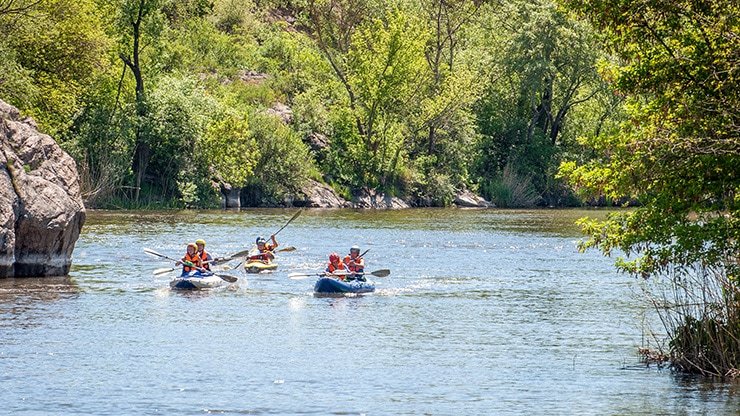
A kayak designed for casual kayaking on calm water. Recreational kayaks are usually wider with great primary stability and are ideal for newbie kayakers.
Reverse Stroke
Starting the paddle stroke next to your hip and drawing the kayak paddle forward toward your feet is what’s called the reverse stroke. You can use it to stop or move the kayak or back up.
River Running
Kayaking downstream in the direction that the river flows while paddling rapids along the way, usually using downriver boats.
Rocker
The curvature of a kayak from bow to stern. A kayak with more rocker appears more curved.
Roof Rack
An accessory for safely transporting your kayak on the roof of your car.
Rudder
A long and narrow blade that can be raised and deployed into the water to help you control the kayak. You can move the rudder from side to side and, consequently, cause the kayak to turn.
S
Scouting
Inspecting a kayaking location before your trip to see what it’s like.
Sculling Draw
In a sculling draw, you move your paddle blade back and forth in short strokes, a foot or two from the side of your kayak. It is an advanced technique performed to move the kayak sideways.
Scupper Holes
Holes in the bottom of a sit-on-top kayak for draining out water that may find its way into the vessel. Scupper plugs go into the scupper holes to prevent water from getting in.
Sea Kayak
A long and narrow sit-in kayak designed for paddling the open water.
Secondary Stability
This is the stability of a kayak when it’s tipped to its side, usually in rough conditions. A kayak with great secondary stability may initially feel tippy on flat water.
Self Rescue
Getting yourself back into your kayak after capsizing.
Shaft
The long narrow part of a kayak paddle that you hold while paddling.
Sit-On-Top Kayak
A kayak with an open cockpit. The paddler sits in a hollow area on the deck. When on a sit-on-top kayak, your entire body is exposed to the elements.
Sit-In Kayak
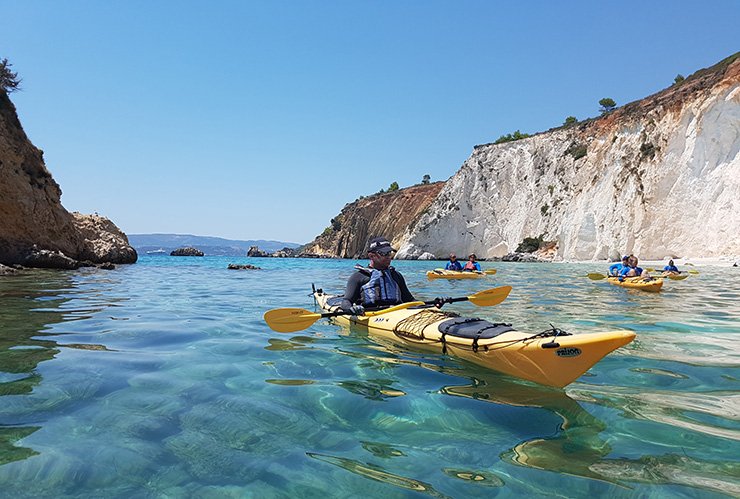
The kayak’s cockpit is enclosed in this type of kayak. Your lower body fits into the cockpit and you stretch your legs under the deck.
Skeg
A blade that resembles a fin, usually attached to the hull of your kayak to help with tracking. Some skegs are retractable.
Spray Skirt
A waterproof cover that goes around your waist and over the rip of the cockpit to prevent water from getting into the cockpit.
Stern
The back part of your kayak.
Strainer
An object that creates a barrier in a river. It allows water to pass through but can trap people and kayaks. Strainers can be deadly.
Stroke
The movement you make with your paddle to propel your kayak on the water.
Surf
To ride waves using your kayak.
Sweep Stroke
This stroke is achieved by making an arch with your paddle from your feet to the back of the kayak. You make the stroke when you want to turn your boat.
T
Take Out
The point where you exit the water and end your kayaking trip.
Tandem Kayak
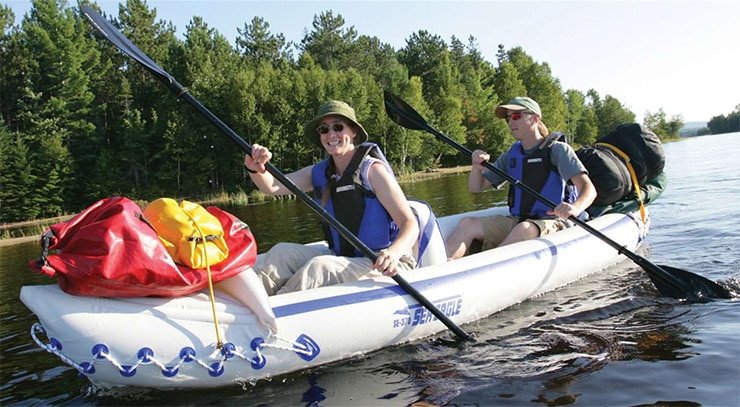
A kayak designed to be paddled by two people, also known as a 2-person kayak, and it will typically have two cockpits.
Thigh Braces
Sit-in kayaks have them within the cockpit to help with thigh positioning and make it easier to control the kayak. You can also get them for your sit-on-top kayak.
Tie-Down Straps
Fasteners for properly securing a kayak to your car roof for transport.
Tracking
The ability of a kayak to travel in a straight line.
U
Upstream
Against the river current.
W
Wet Exit
Exiting a capsized sit-in kayak while wearing your spray skirt. While a spray skirt keeps you dry, it can cause you to get trapped if your kayak capsizes, hence the need for the wet exit technique.
Wetsuit
Unlike dry suits, wetsuits have a tighter fitting and they keep you warm by creating a protective layer of water between the suit and your skin. A wetsuit is not waterproof.
Whitewater
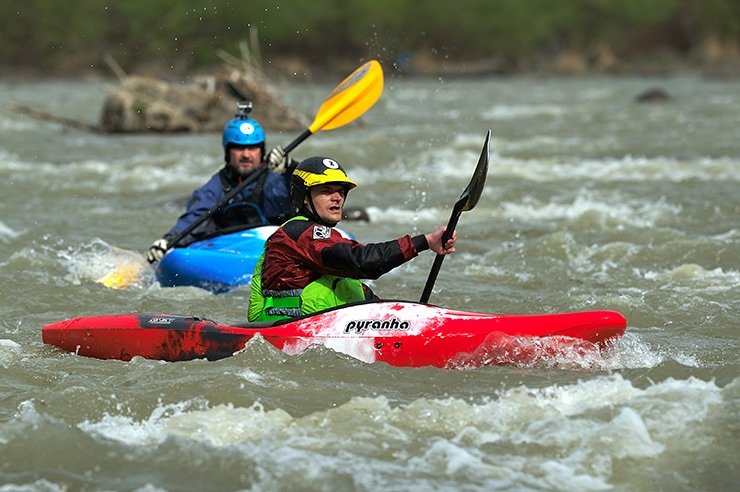
Rough, frothy water that appears white.
Whitewater Kayak
A kayak designed to navigate rough whitewater conditions.
Y
Yak
Another term for a kayak.
Conclusion
Now you know enough kayaking terms to join in conversations the next time you hang out with your kayaker friends. Or when looking up kayak-related information online.

